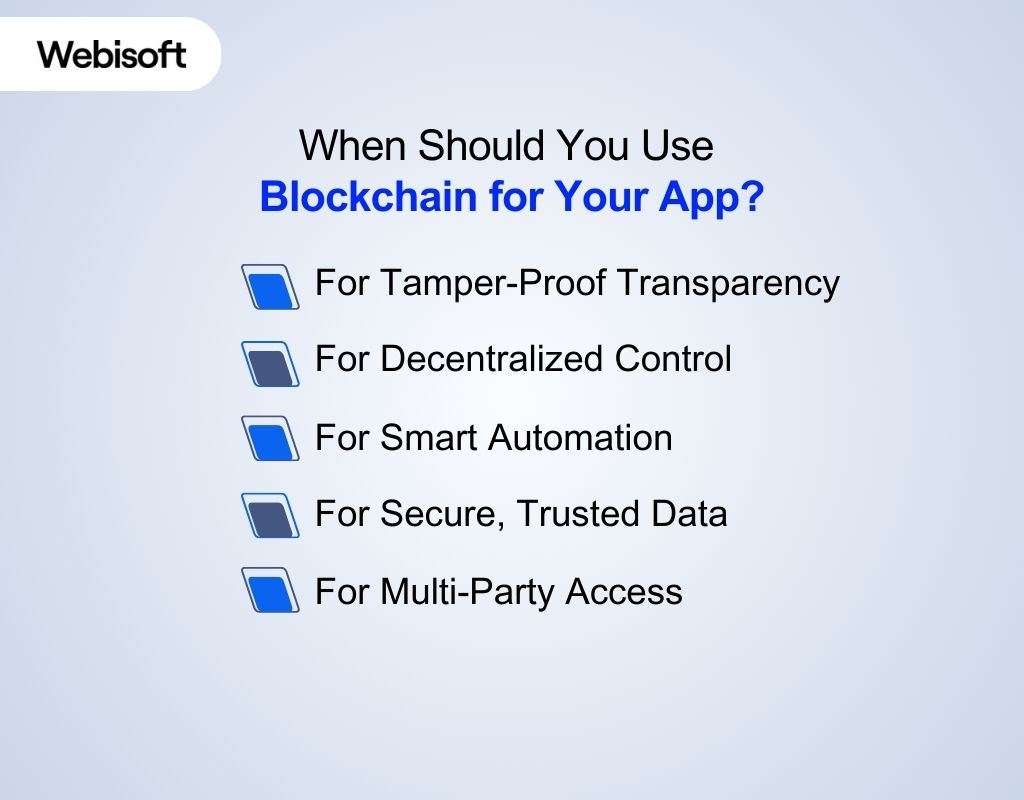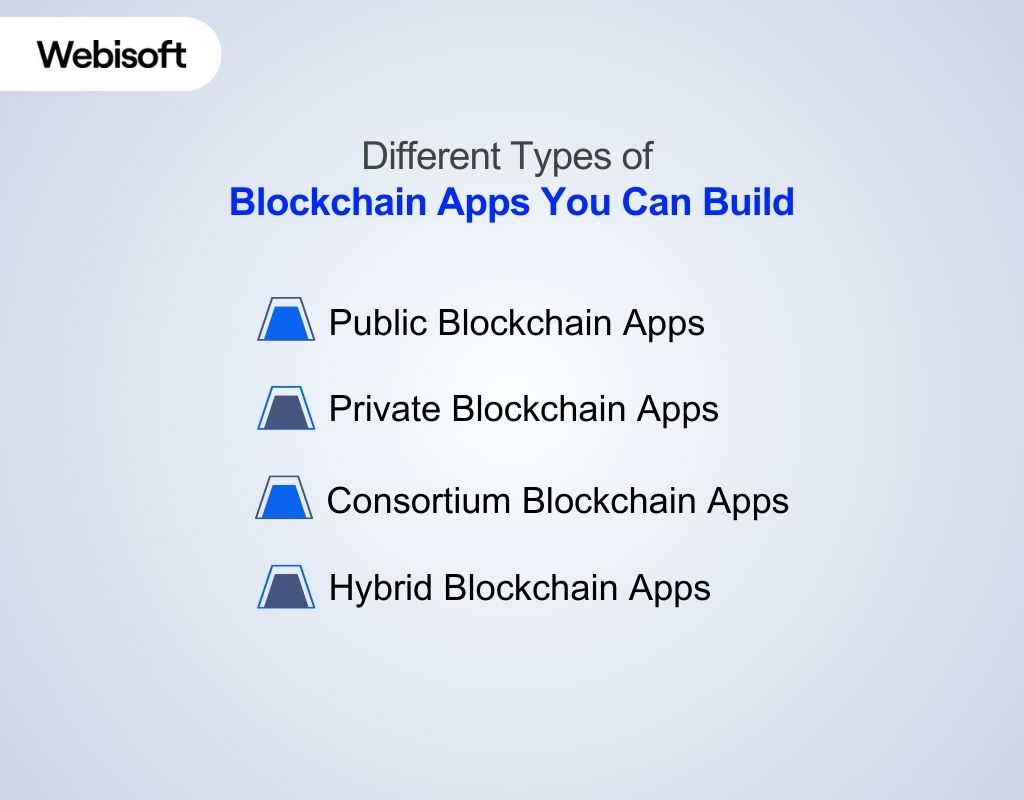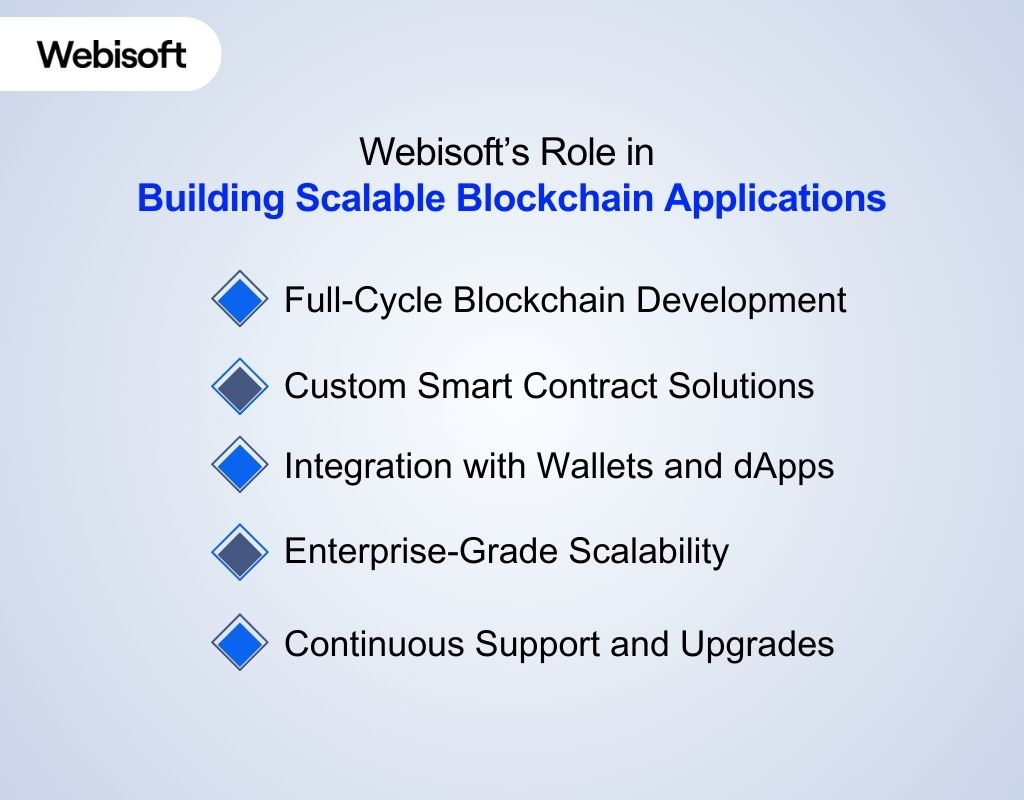How to Create Blockchain Applications in 8 Easy Steps
- BLOG
- Blockchain
- October 17, 2025
If you’re thinking about building a blockchain app, now’s the time. These apps run without central control, making them transparent, secure, and in demand. Industries are already investing heavily, with $19B spent by 2024. Knowing how to create a blockchain application puts you one step ahead of the curve. So, how to create blockchain applications: Choose a real-world use case, pick a blockchain platform, write smart contracts, build the interface, test your app, and launch. Each step helps you create a secure, functional application that runs on a decentralized network. To help you through it, this guide shows you creating blockchain applications from scratch with clear steps, essential tools, and proven practices. That way, you can move from idea to launch confidently, even if you’re new to the space.
Contents
- 1 What Exactly Is a Blockchain Application?
- 2 Build Smarter Blockchain Apps with Webisoft now!
- 3 When Should You Use Blockchain for Your App?
- 4 Different Types of Blockchain Apps You Can Build
- 5 Key Building Blocks Behind a Blockchain Application
- 6 How to Create Blockchain Applications: Step by Step
- 6.1 Step 1: Define the Problem You’re Solving
- 6.2 Step 2: Choose the Right Blockchain Platform
- 6.3 Step 3: Design the App Architecture
- 6.4 Step 4: Write and Test Smart Contracts
- 6.5 Step 5: Build the Frontend Interface
- 6.6 Step 6: Integrate Wallet Support
- 6.7 Step 7: Test the Complete Workflow
- 6.8 Step 8: Launch and Monitor
- 7 Challenges You’ll Face When Building Blockchain Apps
- 8 Webisoft’s Role in Building Scalable Blockchain Applications
- 9 Final Thoughts
- 10 Frequently Asked Question
What Exactly Is a Blockchain Application?
A blockchain application is software that runs on a decentralized network. It uses smart contracts to automate actions, store data securely, and ensure transparency without relying on a central authority or third-party control. Blockchain applications work differently from traditional apps. Instead of using a central server, they operate across many computers, called nodes, that all share and validate the same data. This removes the need for a single point of control, making the system more secure and harder to manipulate. Because of this decentralized setup, every part of the app, from data handling to decision-making, must be built with transparency, verification, and trust in mind. So when you’re planning to build a blockchain application, understanding how these systems operate under the hood is key to doing it right.
Build Smarter Blockchain Apps with Webisoft now!
Turn your blockchain idea into a secure, production-ready application fast.
When Should You Use Blockchain for Your App?
 Before diving into blockchain development, it’s important to know if your app actually needs it. Blockchain isn’t the right fit for every idea, but in the right situations, learning how to create blockchain applications can lead to real value.
Before diving into blockchain development, it’s important to know if your app actually needs it. Blockchain isn’t the right fit for every idea, but in the right situations, learning how to create blockchain applications can lead to real value.
For Tamper-Proof Transparency
If your app requires data that must remain visible and tamper-proof, like transaction history or digital records, blockchain is a strong choice. Every action is recorded and stored across a shared network, so no single party can alter it afterward.
For Decentralized Control
Apps that run without needing trust in a single party are great fits for blockchain. Instead of one system calling the shots, the app logic and data are verified by a distributed network, reducing control risks and single points of failure.
For Smart Automation
Blockchain lets you automate actions using smart contracts, code that runs automatically when certain conditions are met. If your app needs trustless, auto-triggered logic (like releasing funds or verifying inputs), blockchain makes that possible without third-party involvement.
For Secure, Trusted Data
Blockchain keeps all data cryptographically secured and traceable. If your app involves sensitive or high-value information, like digital assets or identity checks, this security model helps ensure the data isn’t tampered with or faked.
For Multi-Party Access
If your app involves several parties who need access to the same data, but don’t fully trust each other, blockchain provides a neutral layer. Everyone sees the same version of data, and no single group can override or control it alone.
Different Types of Blockchain Apps You Can Build
 There’s no one-size-fits-all blockchain app. Depending on what you’re building, the structure and goals may vary. Below are the main types and insights into how to create blockchain applications that fit your needs.
There’s no one-size-fits-all blockchain app. Depending on what you’re building, the structure and goals may vary. Below are the main types and insights into how to create blockchain applications that fit your needs.
Public Blockchain Apps
These apps run on open, permissionless networks like Ethereum or Solana. Anyone can join, verify data, or interact with the app. They’re ideal when you want transparency, openness, and full decentralization with no restrictions on who can access the system. Example: Uniswap is a decentralized exchange (DEX) built on Ethereum. Anyone can swap tokens, provide liquidity, or interact with smart contracts, no central authority involved.
Private Blockchain Apps
These apps operate on closed networks controlled by a single organization. Only selected users can access or modify data. If you need speed, privacy, and controlled access, like for internal operations, private blockchains are often the right fit. Example: IBM Food Trust is a private blockchain platform used by companies like Walmart to track the food supply chain. Only authorized partners (like farmers, suppliers, and distributors) can access or update data.
Consortium Blockchain Apps
Consortium apps are shared between a group of trusted organizations. Each participant helps manage the network. This type is great when multiple parties need to collaborate on shared data without handing control to just one member. Example: Marco Polo Network, built on R3’s Corda, is a consortium blockchain for trade finance involving banks and corporates. It enables secure, real-time sharing of trade data across multiple institutions.
Hybrid Blockchain Apps
Hybrid apps combine both public and private blockchains. Sensitive data stays private, while selected parts are visible to the public. This gives you control, privacy, and transparency, all in one solution, depending on how the app is set up. Example: XDC Network (XinFin) is a hybrid blockchain used in global trade and finance. It keeps confidential trade data on a private ledger but anchors transaction hashes on a public chain for auditability.
Key Building Blocks Behind a Blockchain Application
 To build a working blockchain app, you need more than just code. Each part plays a role in how the app functions, connects to users, and stays secure, explained further in our blockchain concepts guide.
To build a working blockchain app, you need more than just code. Each part plays a role in how the app functions, connects to users, and stays secure, explained further in our blockchain concepts guide.
Smart Contracts
Smart contracts are the core logic of your blockchain app. They run on the blockchain and automatically execute actions based on conditions you define. Once deployed, they can’t be changed, which helps ensure trust, consistency, and fairness across all interactions in your application.
Blockchain Network
This is the foundation your app runs on. It could be Ethereum, Solana, Polygon, or another chain. The network handles validation, stores data, and ensures your smart contracts are executed correctly. Choosing the right network affects speed, cost, and scalability of your app.
Frontend Interface
This is what users see and interact with, usually a web or mobile app. It connects to the blockchain using libraries like Web3.js or Ethers.js. The frontend sends and receives data, displays balances, and lets users interact with smart contracts through an intuitive interface.
Wallet Integration
Wallets like MetaMask or WalletConnect let users sign in and perform actions with their crypto accounts. They connect users to the blockchain, store private keys, and allow transactions. Your app must integrate a wallet so users can interact securely with smart contracts.
Backend Services
Some logic may need to run off-chain, for example, sending notifications or storing app preferences. A backend supports these tasks, often using Node.js or serverless tools. While blockchain handles core functions, the backend improves performance, user experience, and flexibility of your app.
How to Create Blockchain Applications: Step by Step
 Building a blockchain app can seem overwhelming, but it doesn’t have to be. These simple steps will guide you from idea to launch, including how to create blockchain account access through wallet integration and secure user authentication.
Building a blockchain app can seem overwhelming, but it doesn’t have to be. These simple steps will guide you from idea to launch, including how to create blockchain account access through wallet integration and secure user authentication.
Step 1: Define the Problem You’re Solving
Start by identifying a real-world problem that actually needs blockchain. Ask yourself: Do you need transparency, decentralization, or trustless transactions? Not every app needs blockchain, so be sure it’s the right fit. Once clear, map out your app’s goals, users, and core features.
Step 2: Choose the Right Blockchain Platform
Next, pick a blockchain that fits your use case. Ethereum is popular for smart contracts, Polygon offers low fees, and Solana gives high speed. Consider the ecosystem, developer tools, community support, and cost. Your platform choice will affect how your app is built and used.
Step 3: Design the App Architecture
Now plan how your app will function. What logic runs on-chain? What stays off-chain? Decide where smart contracts will be used and how the frontend connects to them. A clear architecture helps avoid errors later and makes your app easier to scale and maintain.
Step 4: Write and Test Smart Contracts
Smart contracts power your app’s core functions. Use languages like Solidity (for Ethereum) or Rust (for Solana). Write clean, secure code and test it thoroughly using tools like Hardhat, Foundry, or Remix. Run unit tests and simulate behavior on testnets before going live.
Step 5: Build the Frontend Interface
This is what your users will see and interact with- part of building intuitive Decentralized Applications (DApps). Use frameworks like React or Vue.js. Connect the frontend to your smart contracts using Web3.js or Ethers.js. Keep the design simple and intuitive so users can interact with the app without needing to understand blockchain.
Step 6: Integrate Wallet Support
Your users need a way to sign in, send tokens, or approve actions. That’s where wallets like MetaMask, WalletConnect, or Coinbase Wallet come in. Integrating wallet access enables users to interact securely, it’s essentially how users create a blockchain account to access transactions and smart contracts.
Step 7: Test the Complete Workflow
Before launch, test every part of your app together. Use public testnets like Goerli or Mumbai to simulate real user interactions. Fix bugs, check transaction flows, and ensure smart contracts respond correctly. This step helps avoid critical issues once your app is live.
Step 8: Launch and Monitor
Once everything works as expected, deploy your smart contracts to the mainnet and launch the app. Set up analytics and monitoring tools to track performance and user activity. Stay ready to fix bugs, respond to feedback, and release updates as needed.
Challenges You’ll Face When Building Blockchain Apps
Building a blockchain app isn’t just about writing smart contracts. You’ll face some unique challenges along the way, technical, financial, and even user-related. Here are the most common issues you should be ready for:
- High Gas Fees: Transactions on some networks like Ethereum can get expensive during peak usage. You’ll need to optimize your smart contracts and consider layer-2 solutions or alternative blockchains.
- Scalability Limits: Public blockchains often process a limited number of transactions per second. If your app grows fast, you might face slow performance or need to move to a more scalable network.
- Security Risks: Smart contract bugs can’t be undone once deployed. One small flaw can lead to major losses, so auditing and thorough testing are absolutely essential before launching.
- Hard-to-Find Talent: Blockchain developers are in high demand and short supply. You may struggle to build or scale a strong team without the right technical partners.
- Regulatory Uncertainty: Blockchain laws vary widely by country and can change fast. You’ll need to stay updated and possibly work with legal experts to avoid compliance issues.
- Data Storage Constraints: Blockchains aren’t meant for storing large files. You’ll need to use off-chain storage solutions like IPFS or Arweave and manage links securely from your smart contracts.
Webisoft’s Role in Building Scalable Blockchain Applications
 Building a scalable blockchain app takes more than just code. You need the right team, tools, and strategy. That’s where Webisoft comes in, guiding you through how to create blockchain applications with deep expertise and end-to-end support that actually delivers.
Building a scalable blockchain app takes more than just code. You need the right team, tools, and strategy. That’s where Webisoft comes in, guiding you through how to create blockchain applications with deep expertise and end-to-end support that actually delivers.
Full-Cycle Blockchain Development
Webisoft handles your project from start to finish. From idea validation to smart contract development and frontend build, Webisoft ensures your blockchain app is scalable, stable, and fully ready for real-world use without gaps.
Custom Smart Contract Solutions
Every blockchain app runs on smart contracts, and Webisoft writes them with security and precision. Whether you’re building DeFi, NFTs, or supply chain systems, they craft smart contracts customized to your goals and tech stack.
Integration with Wallets and dApps
Webisoft makes sure your app connects smoothly to major wallets like MetaMask and WalletConnect. They also integrate your app with other decentralized services, so users can interact easily without friction or confusion.
Enterprise-Grade Scalability
Webisoft designs apps that grow with you. From choosing the right blockchain network to optimizing gas usage, blockchain infrastructure as a service supports high-traffic, long-term performance.
Continuous Support and Upgrades
Blockchain isn’t one-and-done. Webisoft offers post-launch support, including feature updates, security patches, and performance tracking. As your app evolves, they help you stay ahead, without having to rebuild from scratch.
Final Thoughts
Building a blockchain application takes more than just writing code. You need the right use case, platform, blockchain development services, and a solid frontend, all planned carefully. That’s why strategic thinking at every step is key to creating apps that actually work and scale. If you’re serious about how to create blockchain applications, partnering with the right team makes all the difference. Webisoft specializes in building secure, scalable blockchain apps from the ground up. Whether you’re starting with just an idea or need help refining a product, we’re here to guide you.
Frequently Asked Question
Do I need to know coding to create a blockchain app?
Yes, some coding is required. You’ll need to understand languages like Solidity for smart contracts and JavaScript for frontend integration. Even if you use frameworks, a basic grasp of development helps you build and troubleshoot effectively.
How long does it take to build a blockchain app?
Development time depends on complexity. A simple app with basic features may take 3–6 weeks. Larger apps with smart contracts, integrations, and testing phases can take several months to complete, especially if you’re aiming for production-ready quality.
Is it expensive to build a blockchain application?
Costs vary by project. A simple MVP might cost $5,000–$15,000. Full-featured apps with advanced smart contracts, UI/UX, and audits can cost anywhere from $20,000 to $100,000+, depending on scope, platform, and developer expertise.


